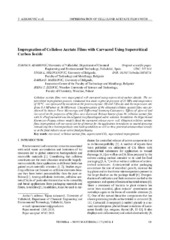Приказ основних података о документу
Impregnation of cellulose acetate films with carvacrol using supercritical carbon ioxide
Impregnacija filmova acetata celuloze karvakrolom pomoću natkritičnog ugljenik(IV)-oksida
| dc.creator | Adamović, Tijana | |
| dc.creator | Milovanović, Stoja | |
| dc.creator | Marković, Darka | |
| dc.creator | Žižović, Irena | |
| dc.date.accessioned | 2021-03-10T13:39:02Z | |
| dc.date.available | 2021-03-10T13:39:02Z | |
| dc.date.issued | 2018 | |
| dc.identifier.issn | 0040-2176 | |
| dc.identifier.uri | http://TechnoRep.tmf.bg.ac.rs/handle/123456789/3817 | |
| dc.description.abstract | Cellulose acetate films were impregnated with carvacrol using supercritical carbon dioxide. The supercritical impregnation process, conducted in a static regime at pressure of 21 MPa and temperature of 50°C, was optimized by variation in the processing time (30 and 120 min) and decompression rate (from 0.3 MPa/min to 36 MPa/min). Characterization of the obtained cellulose acetate films was performed by Atomic Force Microscopy and Differential Scanning Calorimetry. Effects of glycerol and carvacrol on the properties of the films were discussed. Release kinetics from the cellulose acetate film with 31.4% of carvacrol was investigated in a physiological saline solution. In addition, the Higuchi and Korsmeyer-Peppas release models fitted the carvacrol release curve well. Obtained cellulose acetate films impregnated with carvacrol can be of interest for the application in medicine as wound dressings considering their biocompatibility and biodegradability as well as their potential antimicrobial activity or in the food industry as an active food packaging. | en |
| dc.description.abstract | Filmovi acetata celuloze su impregnirani karvakrolom pomoću natkritičnog ugljenik(IV)-oksida. Proces natkritične impregnacije, izveden u statičkom režimu na pritisku 21 MPa i temperaturi 50°C, je optimizovan varijacijom procesnog vremena (30 i 120 min) i brzine dekompresije (od 0,3 MPa/min do 36 MPa/min). Karakterizacija dobijenih filmova acetata celuloze je izvedena pomoću mikroskopije atomskih sila i diferencijalne skenirajuće kalorimetrije. Efekat glicerola i karvakrola na karakteristike dobijenih filmova je objašnjen. Otpuštanje karvakrola iz filma koji je ima 31,4% primos impregnacije karvakrola je ispitano u fiziološkom rastvoru. Dodatno, Higuči i Korsmejer-Pepas modeli otpuštanja su dobro fitovali krivu otpuštanja karvakrola. Dobijeni filmovi acetata celuloze impregnirani karvakrolom mogu biti značajni za primenu u medicini za previjanje rana uzimajući u obzir njihovu biokompatibilnost i biodegradabilnost kao i potencijalno antimikrobno dejstvo ili u industriji hrane kao aktivno pakovanje. | sr |
| dc.publisher | Savez inženjera i tehničara Srbije, Beograd | |
| dc.relation | info:eu-repo/grantAgreement/MESTD/Integrated and Interdisciplinary Research (IIR or III)/45017/RS// | |
| dc.rights | openAccess | |
| dc.rights.uri | https://creativecommons.org/licenses/by/4.0/ | |
| dc.source | Tehnika | |
| dc.subject | carvacrol | en |
| dc.subject | cellulose acetate film | en |
| dc.subject | supercritical CO2 | en |
| dc.subject | supercritical impregnation | en |
| dc.subject | karvakrol | sr |
| dc.subject | film acetata celuloze | sr |
| dc.subject | natkritični ugljenik(IV)-oksid | sr |
| dc.subject | natkritična impregnacija | sr |
| dc.title | Impregnation of cellulose acetate films with carvacrol using supercritical carbon ioxide | en |
| dc.title | Impregnacija filmova acetata celuloze karvakrolom pomoću natkritičnog ugljenik(IV)-oksida | sr |
| dc.type | article | |
| dc.rights.license | BY | |
| dc.citation.epage | 25 | |
| dc.citation.issue | 1 | |
| dc.citation.other | 73(1): 19-25 | |
| dc.citation.rank | M51 | |
| dc.citation.spage | 19 | |
| dc.citation.volume | 73 | |
| dc.identifier.doi | 10.5937/tehnika1801017A | |
| dc.identifier.fulltext | http://TechnoRep.tmf.bg.ac.rs/bitstream/id/9733/0040-21761801019A.pdf | |
| dc.type.version | publishedVersion |

